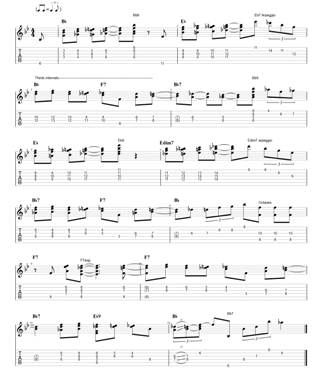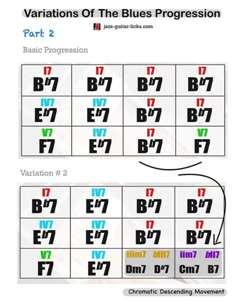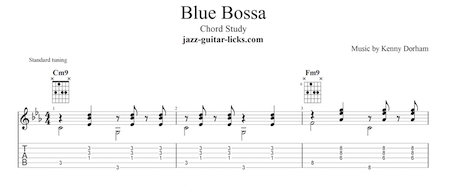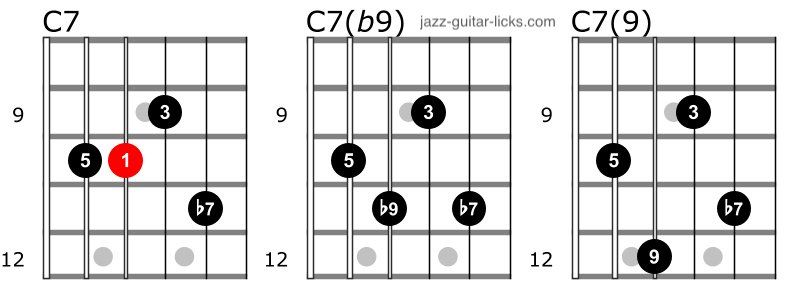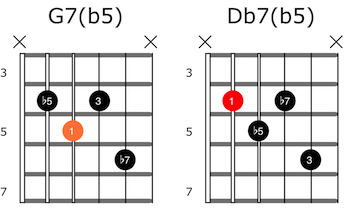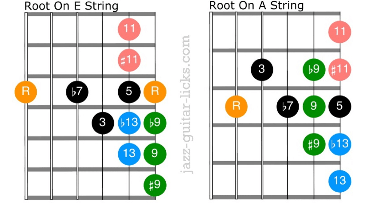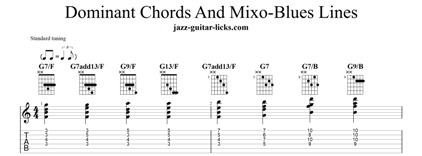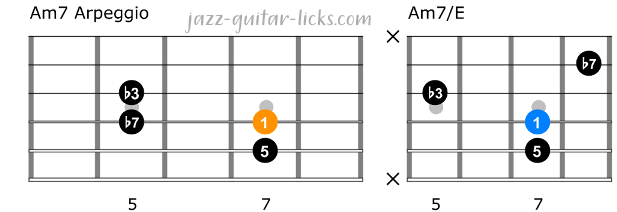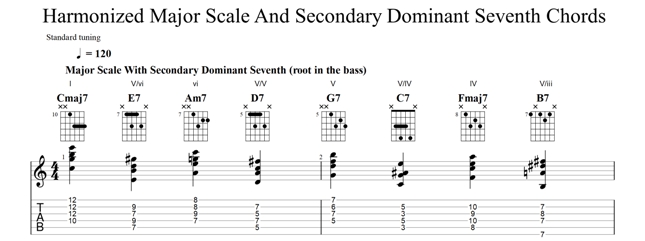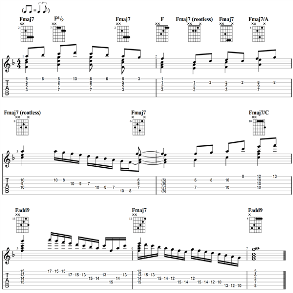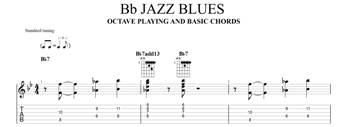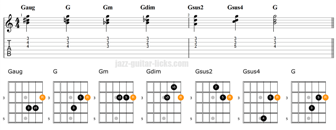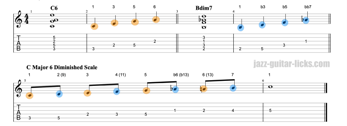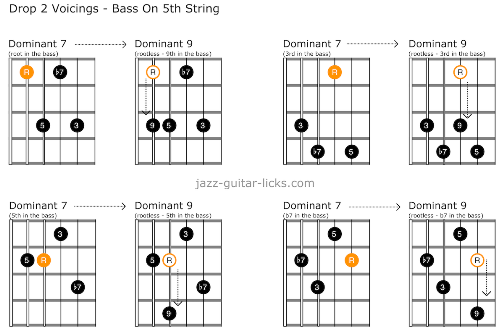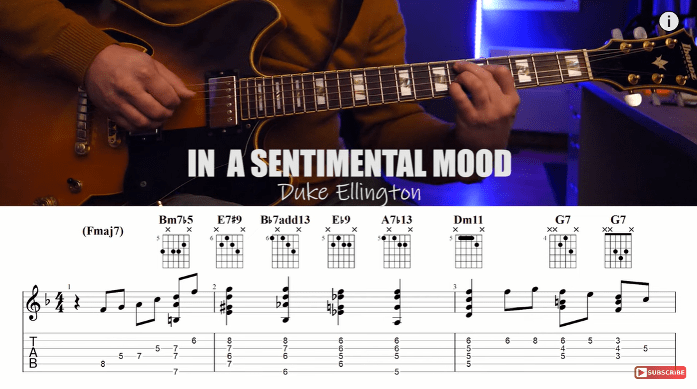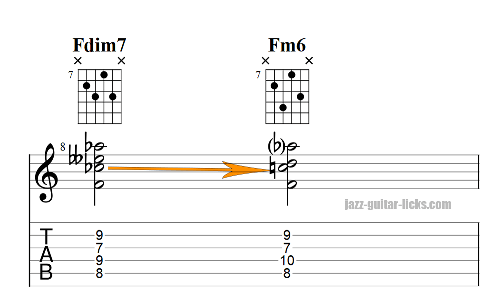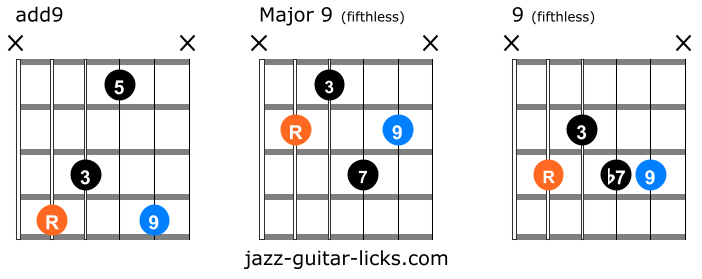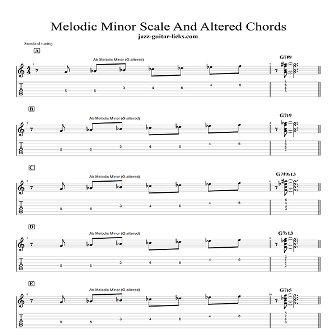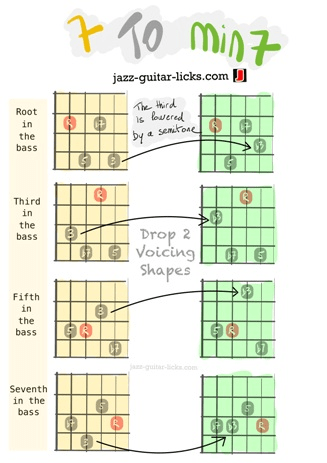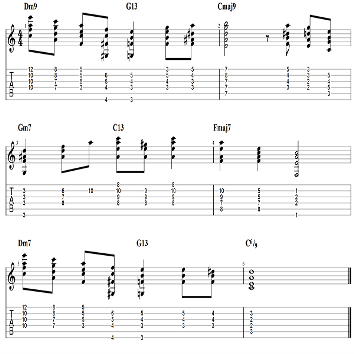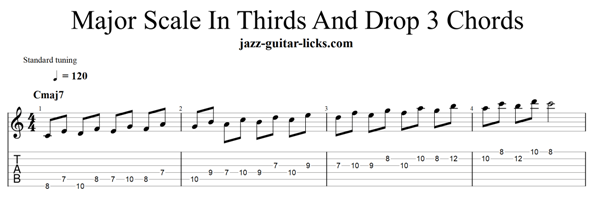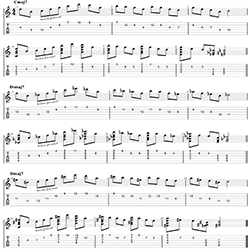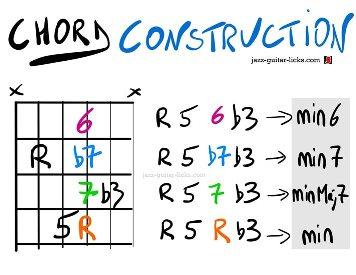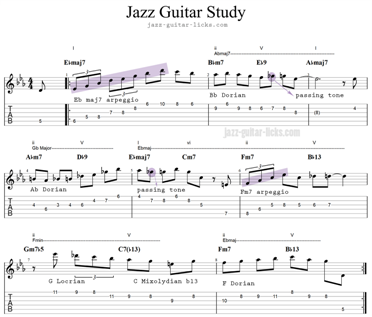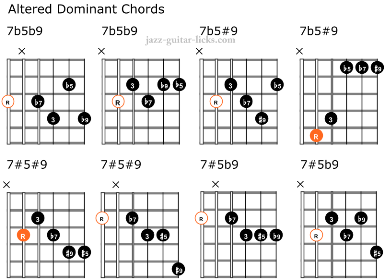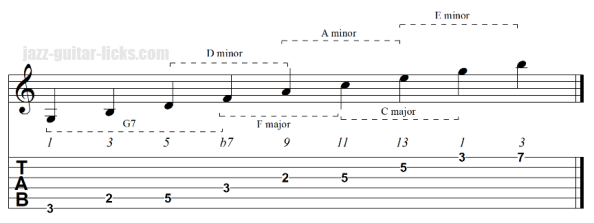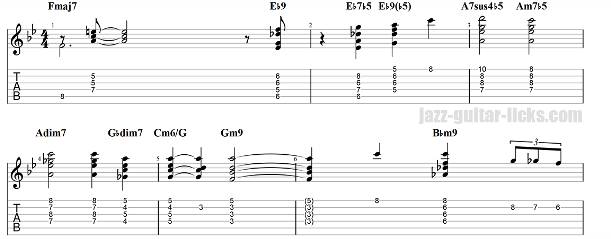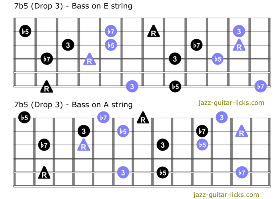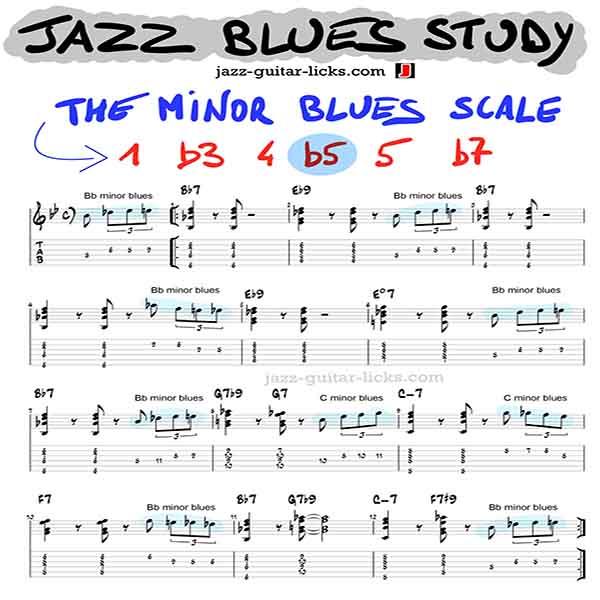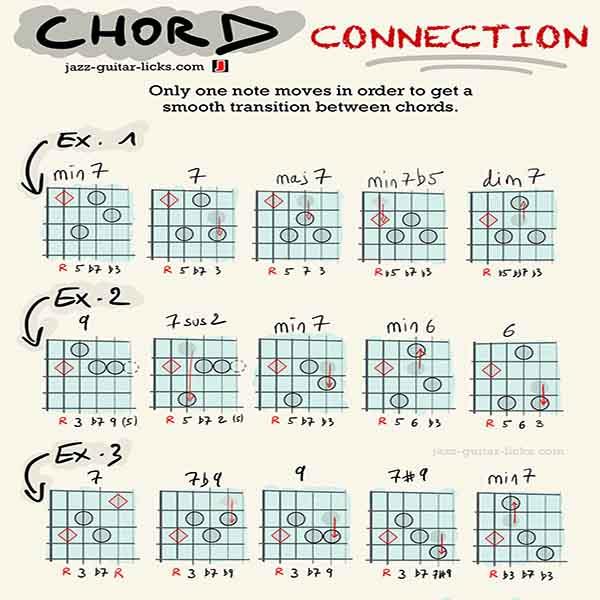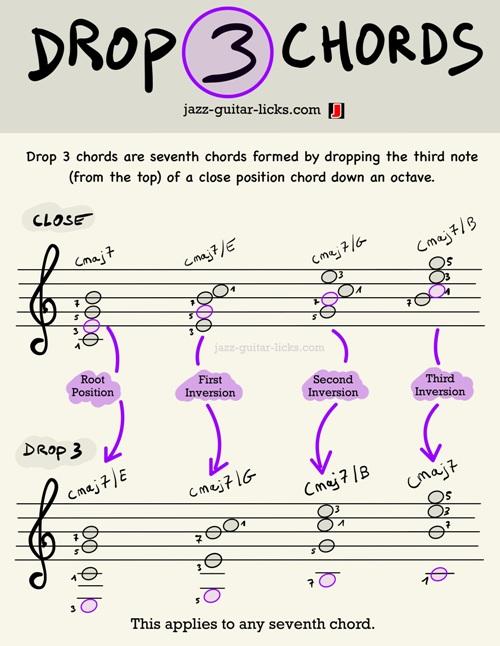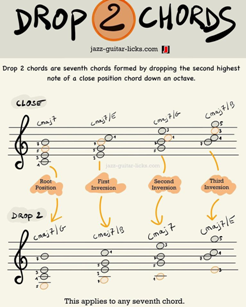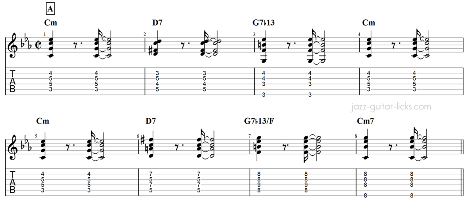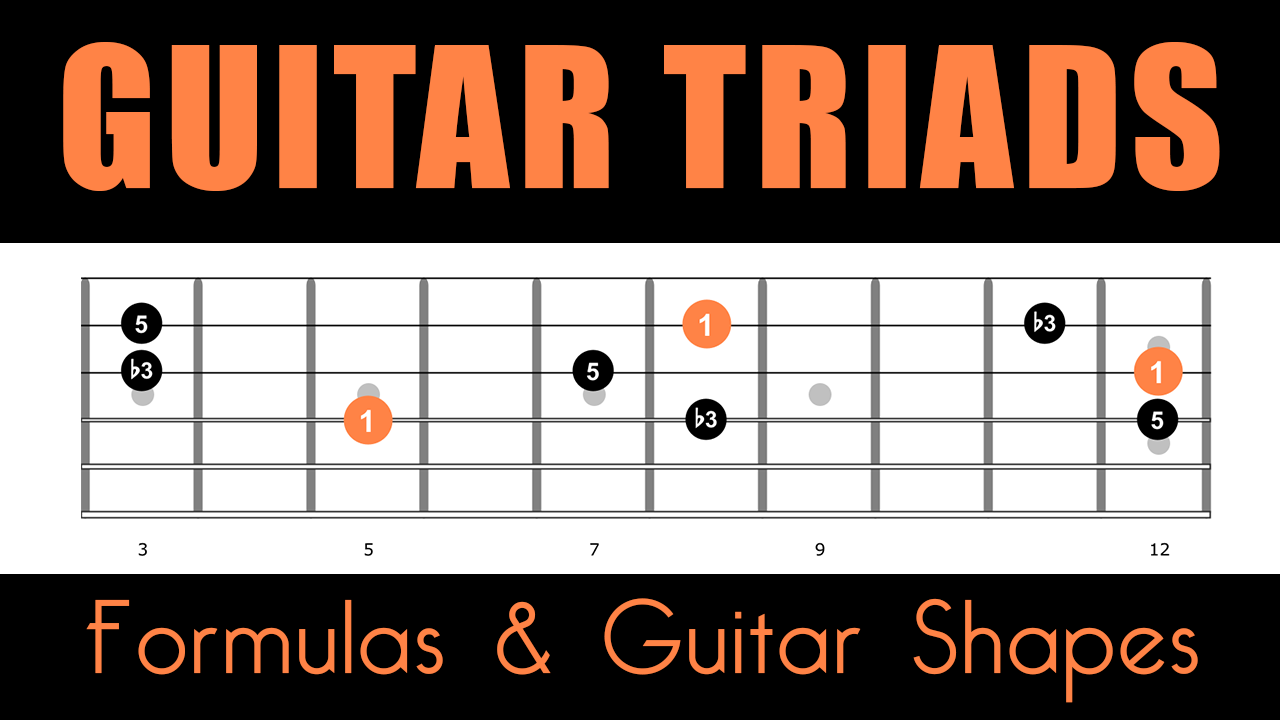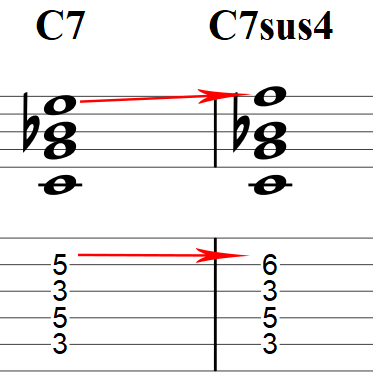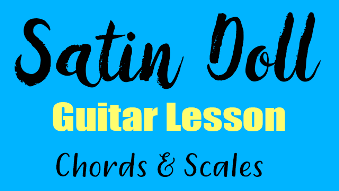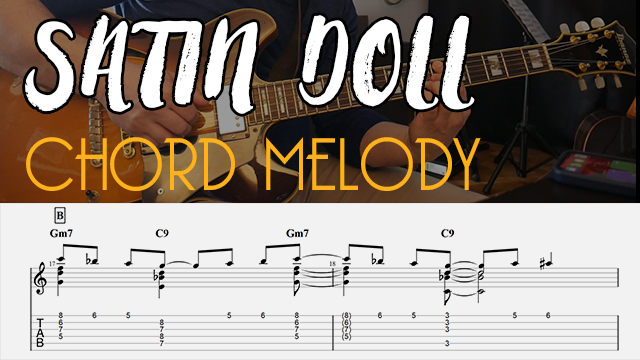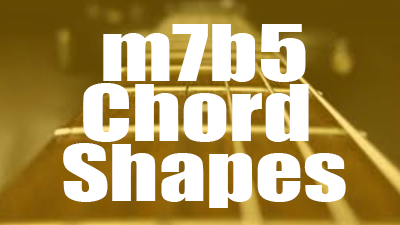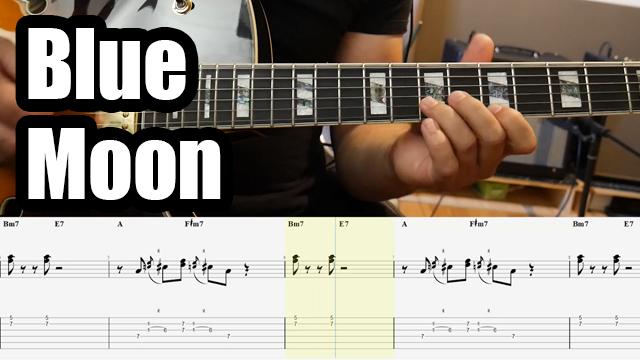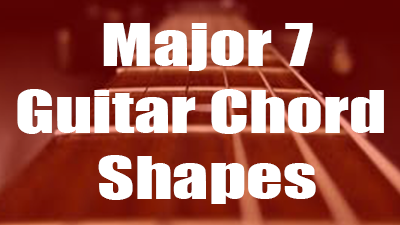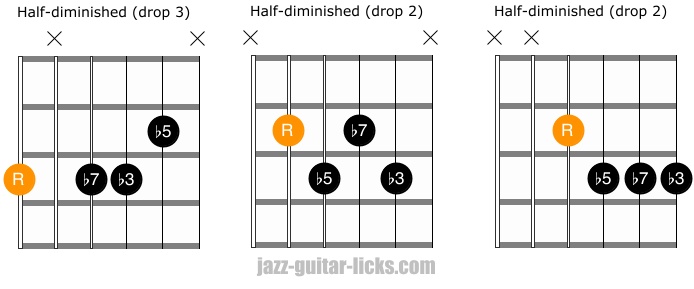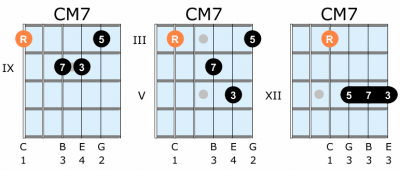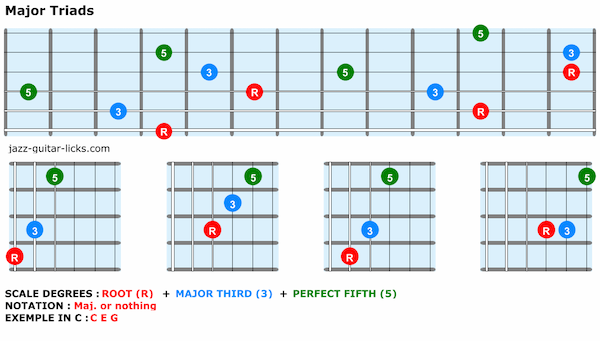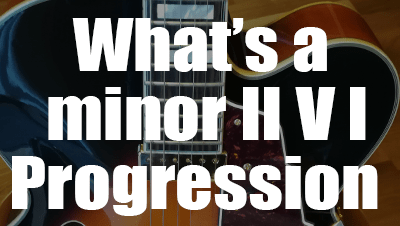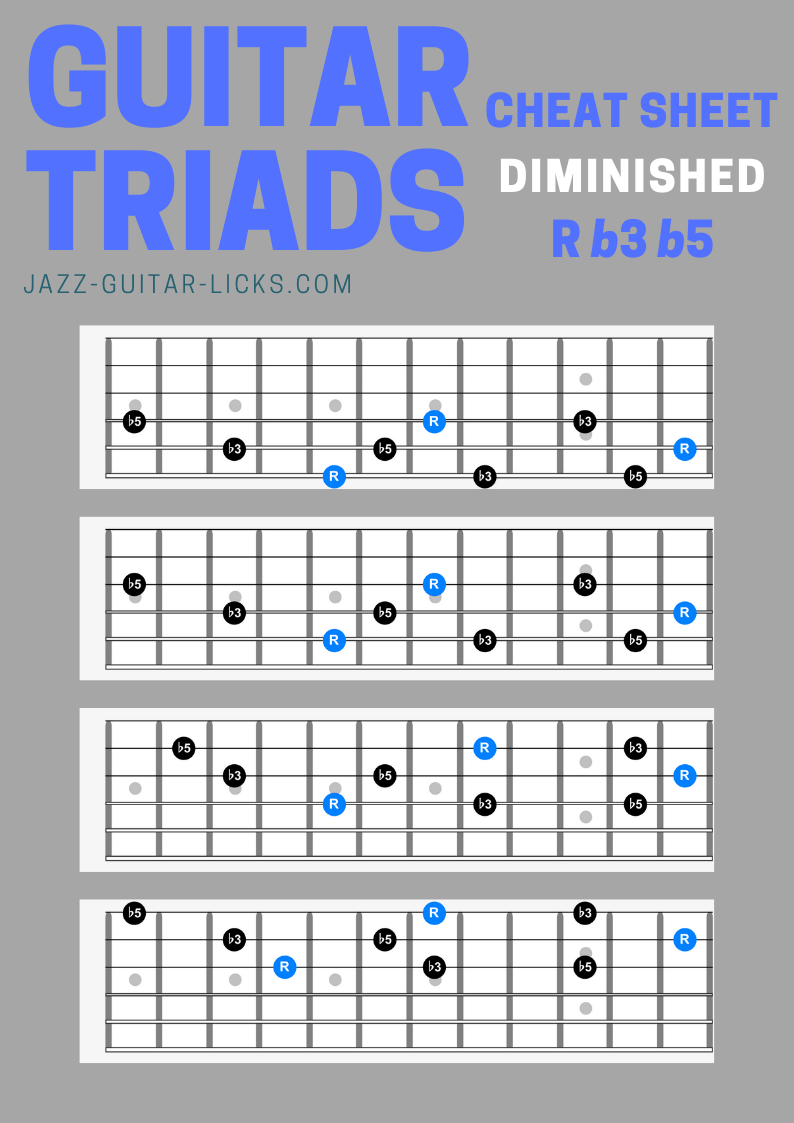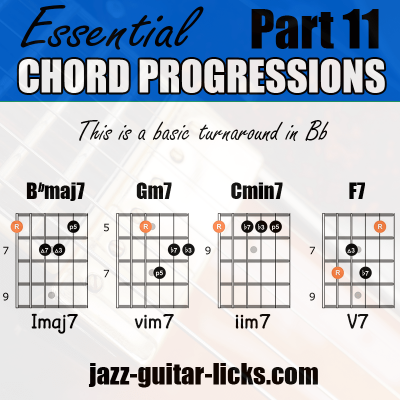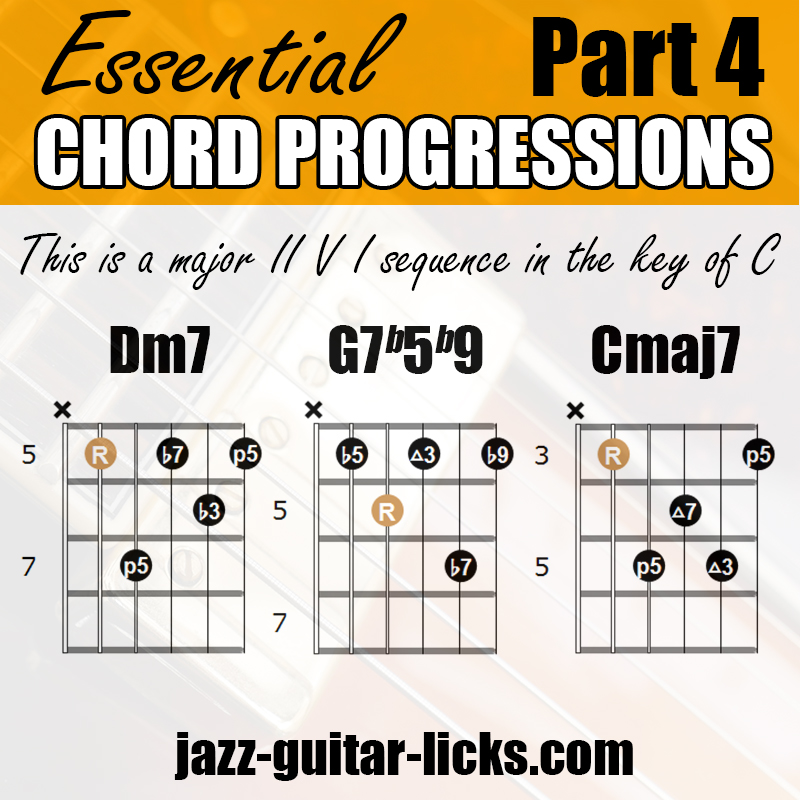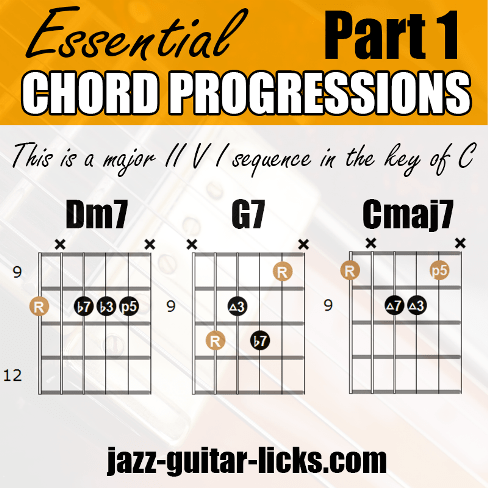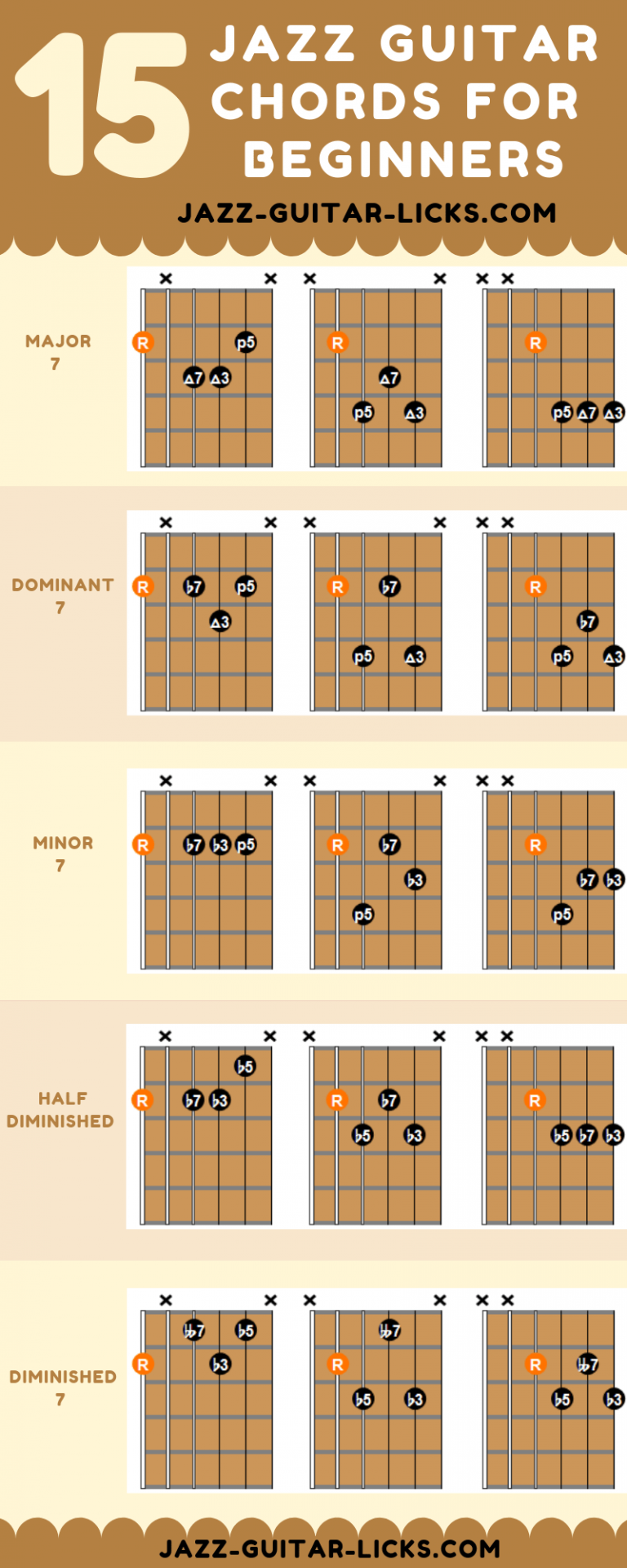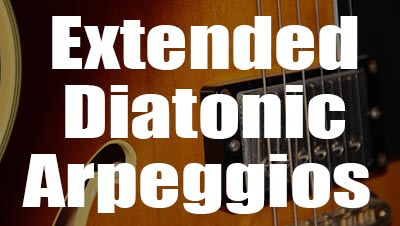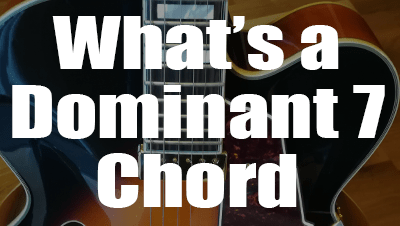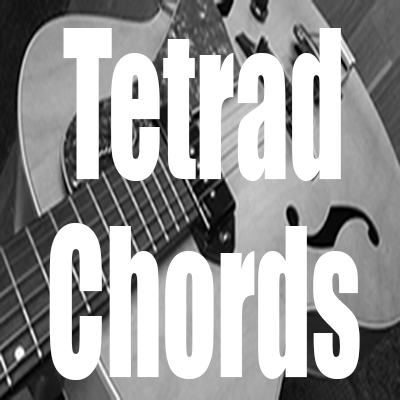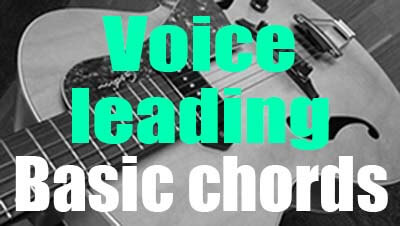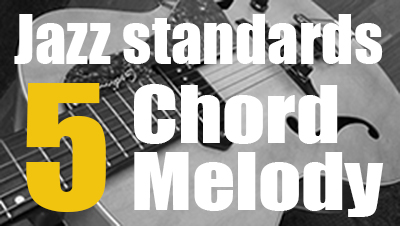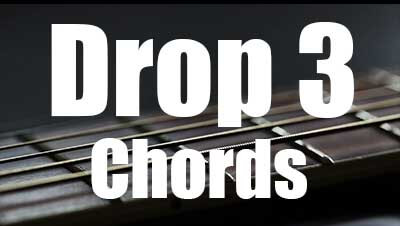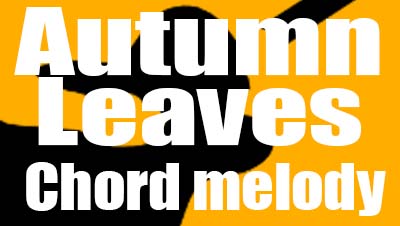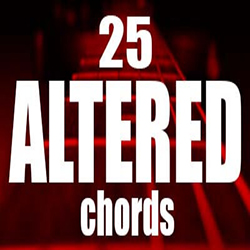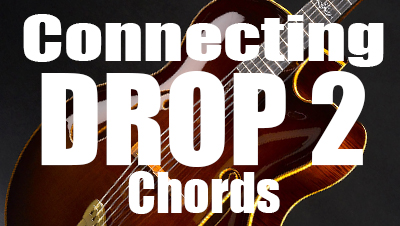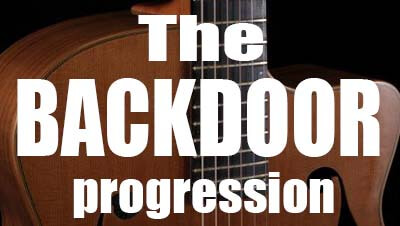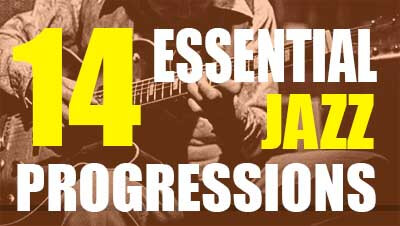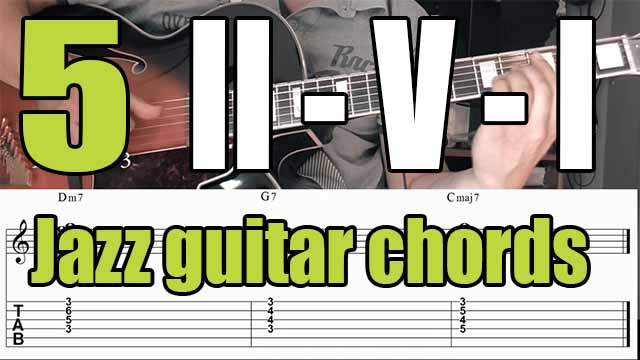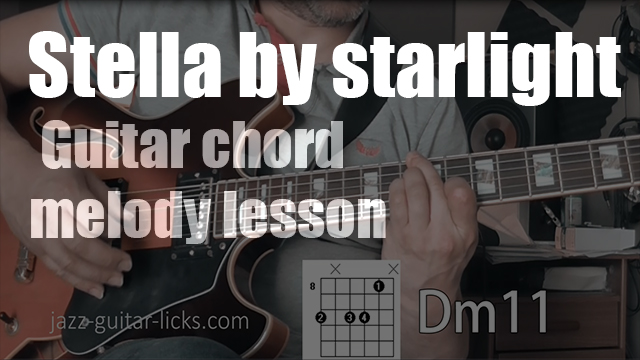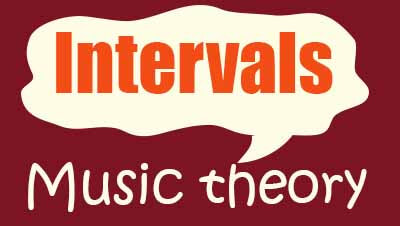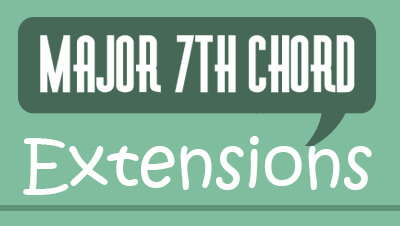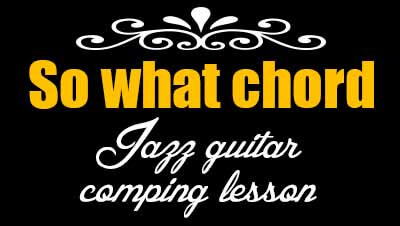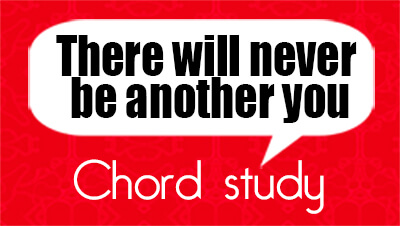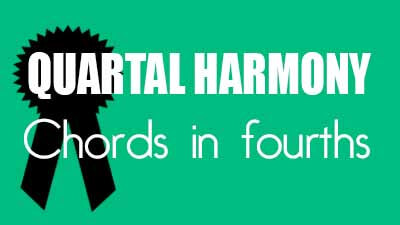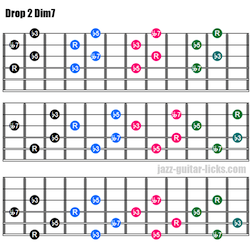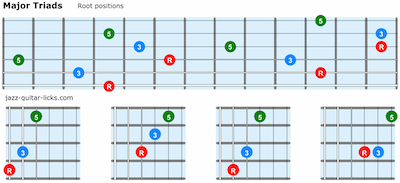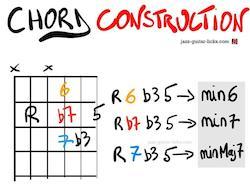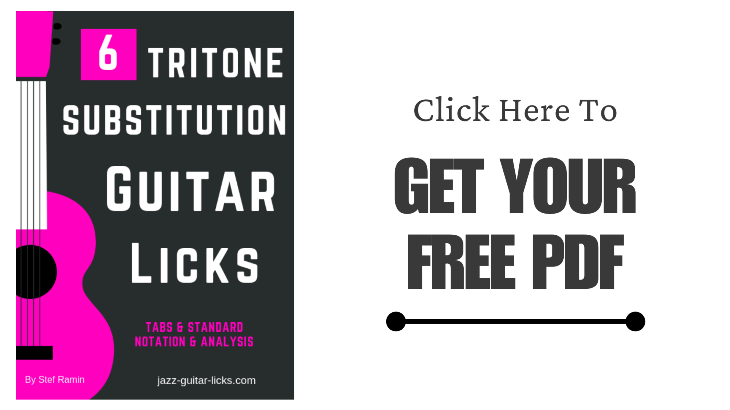Chords / Voicings
Welcome to the blog section dedicated to jazz guitar chords.
You will find here relevant sources of information (tabs, shapes, charts, diagrams) for a better understanding of the main types of chords.
-
Take The A Train - Guitar Chord Melody Arrangement
- By jazz-guitar-licks
- On 2025-06-10
- In Jazz Guitar Lessons
- 0 comments
Welcome to this guitar lesson, where we’ll explore a chord melody arrangement of the classic jazz standard Take The "A" Train by Billy Strayhorn.
This tune, famously associated with the Duke Ellington Orchestra, offers a perfect blend of swing rhythm and rich harmony—ideal for showcasing the beauty of chord melody on guitar.
We’ll break down the melody, harmonize it using jazz voicings, and focus on smooth voice leading to bring the tune to life as a solo guitar piece.
-
What Are Shell Guitar Chords?
- By jazz-guitar-licks
- On 2025-04-13
- In Chords / Voicings
- 0 comments
If you’re looking to clean up your chord work, boost your rhythm chops, and sound more intentional on guitar, shell voicings are a must-have tool in your arsenal.
These chord shapes focus on just the essentials—root, 3rd, and 7th—leaving out the extra notes that can muddy your sound.
Whether you play jazz, blues, funk, or even rock, learning shell voicings will transform the way you approach rhythm guitar.
-
Diatonic Chord Progression And Diminished Passing Chords
- By jazz-guitar-licks
- On 2025-03-09
- In Chords / Voicings
- 2 comments
In this lesson, we’ll explore how diminished 7 chords can be used to create smooth, voice-led connections between diatonic chords, adding tension, movement, and harmonic richness to your playing.
-
Diatonic Major Scale Triads For Guitar - Four Exercises With Tab & Youtube Short
- By jazz-guitar-licks
- On 2025-02-19
- In Chords / Voicings
- 2 comments
Triads are the building blocks of chords and an essential part of understanding harmony on the guitar.
By learning major scale triads, you'll improve your fretboard knowledge, enhance your improvisation skills, and develop a deeper understanding of chord construction.
In this lesson, we’ll break down:
What are the three types of triads found in the major scale.
How to play them across the fretboard on four string sets.
-
Difference Between Dominant 7 Chord And Diminished 7 Chord - Free PDF and YouTube Short
- By jazz-guitar-licks
- On 2024-11-25
- In Chords / Voicings
- 0 comments
In this guitar lesson with free PDF and YouTube short we’ll learn how to turn a dominant 7th chord into a diminished 7th chord.
Free PDF transcription with tab / notation available on GUMROAD and PAYHIP.
-
Blues Monk Guitar Lesson - Chord Melody - Short Vidéo And PDF Transcription
- By jazz-guitar-licks
- On 2024-10-08
- In Jazz Standards
- 0 comments
Here is a guitar study in chord melody of the theme of "Blue Monk" by Thelonious Monk.
The main theme of "Blue Monk" is a simple yet soulful 12-bar blues in Bb.
You can watch the YouTube Short video and download the PDF transcription with tab.
Thanks For Your Support.
-
Chromatic Descending Chord Sequence Over A Basic Blues Progression
- By jazz-guitar-licks
- On 2024-06-25
- In Chords / Voicings
- 0 comments
This guitar lesson for beginners explains what's a basic blues progression and how to add a chromatic descending chord sequence at the end.
-
Warm up Jazz Guitar Exercise - Bebop Melodic Line And 3-note Chords - Free PDF
- By jazz-guitar-licks
- On 2024-04-24
- In Jazz Guitar Lessons
- 0 comments
This lesson offers an easy warm up exercise for guitar implying a bebop melodic pattern and five 3-note chord voicings to play over a 2 5 progression.
You can download the transcription and chord charts in PDF format for free (or give what you want).
In the meantime here is a brief analysis of the lesson :
-
Slash Chords On Guitar - Lesson With Charts And Diagrams
- By jazz-guitar-licks
- On 2024-03-07
- In Jazz Guitar Lessons
- 0 comments
Slash chords, distinguished by a chord followed by a forward slash and a bass note (e.g., C/G), are a powerful tool for enriching your guitar sound.
This guitar lesson for beginners unravels the mystery behind slash chords, revealing how they redefine familiar shapes and add a touch of sophistication to your chord progressions.
-
Blue Bossa - Guitar Chord Study For Beginners - YouTube Short Video - Diagrams & Tabs
- By jazz-guitar-licks
- On 2024-02-08
- In Jazz Guitar Lessons
- 0 comments
"Blue Bossa" is a jazz standard composed by trumpetist Kenny Dorham and one of the most popular Bossa Nova song.
The tune has since become a popular jazz standard, covered by numerous artists as Joe Henderson, Art Pepper, Dexter Gordon and many more.
This guitar lesson provides an easy chord study with tab / notation and YouTube short video to learn how to comp over it.
You'll find the related PDF transcription in the GUMROAD STORE.
-
6 Types Of Extended & Altered Dominant 7 Chord Voicings For Guitar
- By jazz-guitar-licks
- On 2024-02-03
- In Chords / Voicings
- 0 comments
In this short guitar lesson you will learn how to play 6 types of altered and extented dominant chords (7, 7b9, 9, 7b5, 7b5b9, 9b5) to expand your harmonic vocabulary.
-
How To Use Diminished 7 Chords On Guitar - 4 Examples
- By jazz-guitar-licks
- On 2024-01-17
- In Chords / Voicings
- 0 comments
Diminished 7 chords bring a distinctive, mysterious sound to music.
Widely used in jazz and classical genres, they infuse tension and creativity into your playing.
This guitar lesson explains how they are built and how to use them thanks to four easy examples.
-
How To Mix Chords And Modes Of The Harmonic Minor Scale - Free PDF And YouTube Short Video
- By jazz-guitar-licks
- On 2024-01-04
- 0 comments
The harmonic minor scale is a captivating and versatile scale used in various musical genres, known for its distinctive sound due to the raised seventh degree compared to the natural minor scale.
By understanding both chords derived from this scale and the modes within it, you can create compelling harmonic progressions and melodic lines.
Here's an introduction on how to combine chords and modes derived from the harmonic minor scale, including a free PDF (or give what you want) with Tab / standard notation.
-
Chord Substitution - Enharmonic Equivalents - Altered & Extended Dominant Seventh Chords
- By jazz-guitar-licks
- On 2023-12-19
- 0 comments
This guitar theory lesson about harmonic equivalents provides six examples, that demonstrate how dominant seventh chords (rootless, altered or extended) can also be considered as other types of chords (min6, dim7, 7).
-
Mixolydian Sus4 Chords On Guitar - Voice Leading - Lesson With Tabs
- By jazz-guitar-licks
- On 2023-10-14
- In Chords / Voicings
- 0 comments
This short guitar lesson is to practice voice leading with 10 different sus4 chord voicings built with notes from the G Mixolydian mode. Transcription with Tab & Short video available at the end of the article.
-
Dominant 7 Chord Extensions - Infographic With Guitar Neck Diagrams
- By jazz-guitar-licks
- On 2023-09-18
- In Chords / Voicings
- 0 comments
This brief guitar theory lesson explains what is a dominant 7 chord and its possible extensions (natural and altered) thanks to a printable infographic containing two neck diagrams.
-
14 Dominant Chords And Mixo Blues Lines / Voice Leading / Guitar Lesson With Free PDF & Short YouTube Video
- By jazz-guitar-licks
- On 2023-09-15
- In Jazz Guitar Lessons
- 0 comments
This short guitar lesson provides 14 ways of connecting dominant chord voicings on the same string set (7 and extended) and three easy lines using the Mixo Blues Scale. A free transcription in PDF (or give what you want) is available here on the GUMROAD store.
-
Arpeggio And Chord Connection - Maj7, 7, min7, m7b5, dim7, min6 and 6 - Warm-up Exercise For Beginners
- By jazz-guitar-licks
- On 2023-09-06
- 0 comments
Arpeggios are a fundamental aspect of music theory and play a pivotal role in creating expressive melodies, harmonies, and improvisations across various musical genres. In this exploration of basic arpeggios, we will learn how to connect Maj7, 7, min7, m7b5, dim7, min6, and 6 arpeggios (by moving only one note at a time) and how to make the link with basic chord shapes.
-
Major Scale And Secondary Dominant Seventh Chords - Free PDF Transcription And YouTube Short Videos
- By jazz-guitar-licks
- On 2023-08-17
- 2 comments
This guitar lesson implies playing secondary dominant seventh chords of the harmonized major scale.
Free PDF available on GUMROAD and four YouTube short videos at the bottom of this page.
-
Dominant, Subdominant, Secondary Subdominant and Secondary Dominant Chords - Guitar Theory Lesson
- By jazz-guitar-licks
- On 2023-07-30
- 0 comments
In music theory, the terms "dominant," "subdominant," and "secondary dominant" are used to describe different types of chords and their functions within a key or harmonic progression.
Here's an explanation of each term with examples for guitar players.
-
F Major Mastery: Exploring Chords and Melodies on Guitar - Free Transription & YouTube Short
- By jazz-guitar-licks
- On 2023-07-10
- In Jazz Guitar Lessons
- 0 comments
This is a short guitar study that combines various chord voicings and melodic patterns based on the F major scale. This study includes a short video demonstration as well as a free (or give what you want) downloadable PDF guide for reference and practice.
-
Major Scale Harmonized In 3-Note Chords - Guitar Lesson With YouTube Short, Diagrams And Tabs
- By jazz-guitar-licks
- On 2023-06-14
- 0 comments
This lesson provides a short guitar exercise that will expand your theoretical notions and fretboard knowledges. The principle being to harmonize the C major scale with 3-note chords also referred to as shell voicings while inserting short lines (from the major scale) between each chord.
-
Basic Chords And Octave Playing Over A Blues In Bb - Lesson With PDF And YouTube Short Video
- By jazz-guitar-licks
- On 2023-06-10
- In Jazz Guitar Lessons
- 0 comments
This jazz guitar lesson for beginners provides an easy study to practice octave playing and basic jazz chords over a Blues in Bb. It is available as a YouTube Short Video and a free transcription in PDF with chord shapes tab and standard notation.
-
Solar By Miles Davis - 2 Chord Studies For Beginners
- By jazz-guitar-licks
- On 2023-05-23
- 0 comments
Here are two easy guitar chord studies to apply over the jazz tune Solar by Miles Davis. The first one implies 3-Note chords while the second implies 4-note chords. Free PDF and YouTube Short video available.
-
Triad Chord Connections - Short Guitar Tutorial With Free PDF
- By jazz-guitar-licks
- On 2023-05-04
- 2 comments
In this short lesson for beginners you will learn how to build basic triad chords on guitar, how to connect, hear and recognize them in an easy way, step by step. Four exercises with tab/standard notation and neck diagrams are proposed here, the aim being to play the six main types of triads on different string sets without displacing the hand.
-
30 Types Of Open A Chords - Free Cheat Sheet With Diagrams
- By jazz-guitar-licks
- On 2023-04-14
- 0 comments
This cheat sheet provides 30 voicing shapes for playing 30 types of open A chords on guitar :
Am, A, A+, Asus4, Asus2, Amadd9, A5, A6, Am6, A6/9, Am6/9, A7, Adim7, A7sus4, Amaj7, Am7, AmMaj7, Amaj7b5, Am7b5, A7+, A7b5, A7b9, A7#9, A7#5b9, A9, Amaj9, Am9, A11, Am11, A13.
-
The Major Sixth Diminished Scale - Jazz Guitar Lesson Around The Barry Harris Concept
- By jazz-guitar-licks
- On 2023-03-20
- In Jazz Guitar Lessons
- 2 comments
This guitar lesson is about a harmonic concept mapped out and developped by jazz musician Barry harris that can be found in the book "The Barry Harris Harmonic Method For Guitar" by Alan Kingstone.
This blog article details a little bit more in depth about what is the major 6 diminished scale and how to harmonize it with major 6 and diminished 7 chords.
FREE PDF AVAILABLE HERE ON THE GUMROAD STORE
-
How To Turn A 7th Chord Into A Rootless 9th Chord - Theory Lesson For Guitarists
- By jazz-guitar-licks
- On 2023-02-15
- 2 comments
This chord theory lesson focuses on how to transform a dominant 7 chord (drop 2, drop 3 and related inversions) into a rootless ninth chord by replacing the tonic (1) with the ninth (9).
This technique will help guitarists expand their harmonic knowledge and also explore their neck in more depth. This can be a useful trick when composing or for chord melody arrangements.
-
Jazz Guitar Chord Melody Arrangement - In A Sentimental Mood By Duke Ellington
- By jazz-guitar-licks
- On 2022-12-20
- In Jazz Guitar Lessons
- 2 comments
This video with tab and diagrams is a chord melody arrangement for jazz guitar of the famous Duke Ellington's jazz tune "In A Sentimental Mood". The aim being to mix the melody and the chords together as a piano player would do.
-
Diminished 7 Chords - Connections With Dominant 7 And Minor 6
- By jazz-guitar-licks
- On 2022-12-11
- 0 comments
In this guitar lesson you will learn how to transform a diminished 7 chord into a dominant 7 and also a minor 6 chord either by lowering or raising only one note in order to get a smooth transition.
Check the GUMROAD shop to get the free PDF.
-
Difference Between Fully Diminished 7 And Half-Diminished - Guitar Lesson With Formula Chart And Neck Diagrams
- By jazz-guitar-licks
- On 2022-11-28
- 0 comments
This blog article dedicated to guitarists answers the question that many beginner musicians ask themeselves :
What is the difference between half-diminished and fully diminished (Diminished 7) ?
-
Differences Between Maj9, add9 and 9 Chords - Music Theory For Guitar With Charts And Neck Diagrams
- By jazz-guitar-licks
- On 2022-11-16
- 0 comments
This guitar lesson with charts and shapes will help you understanding the differences between major 9, add9 and dominant 9 Chords. How they are built and how to play them on guitar.
-
Medodic Minor Scale And Altered Dominant Seventh Chords - Guitar Lesson With Free PDF and Short Video
- By jazz-guitar-licks
- On 2022-09-23
- In Jazz Guitar Lessons
- 0 comments
This guitar lesson provides 10 easy exercises for understanding the relationship between the Melodic Minor Scale and altered dominant seventh chords. This is a free course (or give what you want) with a printable PDF with tab/standard notation and a YouTube short video.
-
Dominant 7 To Minor 7 Chords - Drop 2 Voicings Shapes For Guitar
- By jazz-guitar-licks
- On 2022-09-07
- In Guitar Cheat Sheets, Methods, eBooks, Posters
- 0 comments
This guitar cheat sheet shows the relation between a dominant 7 chord and a minor 7 chord. All the shapes are drop 2 voicings with bass notes on the fifth string. The aim being to move only one note at a time, separated by a half step (one semitone).
-
Chord Extensions - Music Theory Lesson
- By jazz-guitar-licks
- On 2022-06-07
- 0 comments
In this theory lesson we will see how to add natural and altered extensions to 7th chords. The aim being to bring new colors and so to embellish your chord progressions. This concept is a very important device for composing, chordal accompaniment and chord-melody arrangements.
-
2-5-1 Guitar Chord Voicings - Joe Pass Style - Video and Free PDF
- By jazz-guitar-licks
- On 2022-05-17
- 0 comments
Here is a free lesson to learn some 2-5-1 jazz chord voicings in the style of Joe Pass. PDF with tab and Youtube short video available for free (or give what you want) here in the GUMROAD ONLINE SHOP.
-
Natural Minor Scale Harmonization - Guitar Theory Lesson
- By jazz-guitar-licks
- On 2022-04-13
- 2 comments
This guitar theory lesson covers a very important topic that any musician must know : How To Harmonize The Natural Minor Scale?
You will learn how to build triads and seventh chords starting on each note of the natural minor scale.
-
Major Scale In Thirds And Drop 3 Chords With Walking Bass Lines For Guitar - Lesson With Video and Free PDF
- By jazz-guitar-licks
- On 2022-04-10
- 0 comments
Here is a new free guitar lesson showing how to play the major scale (C major) in thirds. This two-in-one exercise also includes an easy walking bass line built with drop 3 chords. The full transcription with tab/score is downloadable in a PDF format here in the Online Shop.
-
Difference Between Dominant 7 and Major 7 Chords - Music Theory For Guitar
- By jazz-guitar-licks
- On 2022-04-04
- In Chords / Voicings
- 0 comments
This theory lesson for guitarists covers one the most common question asked by beginner musicians : what's the difference between a dominant seventh and a major seventh chord.
-
Major Lick Harmonized and Transposed - Jazz Guitar Lesson With Free PDF
- By jazz-guitar-licks
- On 2022-02-10
- 0 comments
This blog post provides a guitar lesson implying a basic jazz line, built with notes from the Ionian mode (major scale), harmonized and transposed in halftone steps. Once again you'll find the free PDF of the lesson transcribed in tab / standard notation in the GUMROAD SHOP and also the related Youtube short video at the bottom.
-
Guitar Chord Construction and Connection - Cheat Sheets With Shapes and Intervals
- By jazz-guitar-licks
- On 2021-12-12
- In Chords / Voicings
- 0 comments
This page provides a collection of cheat sheets explaining in a simple and effective way how guitar chords are built and how they are connected one to the other. The idea is to understand where are located each chord tone of a specific voicing and how to connect these chords them by moving only one note at a time. Notice that this page is regularly updated with new shapes, don't forget to subscribe the newsletter to stay informed.
-
Jazz Guitar Phrases Over Common Changes - II V I and I VI II V - PDF With Tab, Shapes and Video (part 1)
- By jazz-guitar-licks
- On 2021-11-09
- In Jazz Guitar Lessons
- 0 comments
This short jazz guitar study with tab, score and chord charts provides some easy jazz lines to apply over three common chord progressions found in jazz. These licks will help you better understand what scales and modes can be used over basic chord changes. You'll find a link to the free PDF at the end of this lesson.
-
Altered Chords - Guitar Lesson With Shapes and Theory
- By jazz-guitar-licks
- On 2021-10-26
- In Chords / Voicings
- 0 comments
Altered chords add color, tension, and sophistication to your playing, making them a must-know for jazz, fusion, and even blues and rock guitarists.
An altered chord contains one (or several) altered notes that don't belong to the diatonic scale.
These notes are the b5 (flat fifth), #5 (sharp fifth), b9 (flat ninth), #9 (sharp ninth).
In this guitar lesson we will see that they can be grouped into three disctinct families (major, minor and dominant) and also how to play them on guitar.
-
Superimposed Triads - Guitar Infographic
- By jazz-guitar-licks
- On 2021-10-23
- In Infographics
- 0 comments
You'll find here an infographic related to the lesson about upper structure triads on guitar.
-
Upper Structure Triads For Guitar - Lesson With Charts and Tabs
- By jazz-guitar-licks
- On 2021-10-22
- In Chords / Voicings
- 0 comments
This guitar lesson discusses a very useful way to come out new colors to your soloing or comping ideas called "Upper-structure Triads".
This technique consists of superimposing triads to highlight extended notes of minor, major and dominant chords.
-
Days of Wine And Roses - Guitar Chord Melody Lesson With Tab
- By jazz-guitar-licks
- On 2021-10-19
- 0 comments
This lesson provides a chord melody arrangement for guitar of the famous song "Days of Wine and Roses" written by Henry Mancini (music) and Johnny Mercer (lyrics) for the movie film of the same name.
-
How to Use 7b5 Chords? Guitar Lesson With Shapes and Tabs
- By jazz-guitar-licks
- On 2021-10-12
- 0 comments
Altered chords are a very important part of jazz language, they are built by altering with a flat or a sharp one or more notes of a diatonic chord. They are very useful to bring a little bit of tension to any jazz chord progression.
This lesson focusses on dominant seventh flat fifth chords (7b5), that are dominant seventh chords with a lowered fifth, given the formula : root (R), third (3), flat fifth (b5) and minor seventh (b7).
-
Jazz Blues Guitar Study - Basic Chords and Minor Blues Scale
- By jazz-guitar-licks
- On 2021-10-07
- In Jazz Guitar Lessons
- 0 comments
Here is 12-bar jazz-blues study in Bb with guitar tab and standard notation mixing basic jazz chords and minor blues scale fragments. You'll find it for free (or Pay What You Want) on jazz-guitar-licks Gumroad store.
-
Extended and Altered Dominant Guitar Chord Shapes - Free PDF Chart
- By jazz-guitar-licks
- On 2021-10-04
- In Guitar Cheat Sheets, Methods, eBooks, Posters
- 0 comments
This free guitar chord chart available as a PDF file contains the most important altered and extended dominant guitar chord shapes that any guitar player should know. It is totally free (or Pay What You Want) in return, don't hesitate to support this website.
-
Chord Connections - 3 Exercises For Guitar - PDF Cheat Sheet
- By jazz-guitar-licks
- On 2021-09-20
- In Chords / Voicings
- 0 comments
Here is a cheat sheet containing three easy exercises for connecting basic guitar chord shapes as min7, maj7, dim7, m7b5, 7sus, 9th, 7#9, 7b9, min6, 6. It is available for free (or Pay What You Want) in Jazz Guitar Licks Gumroad Shop.
-
Drop 3 Chord Construction - Music Theory - Free Printable PDF
- By jazz-guitar-licks
- On 2021-09-09
- In Guitar Cheat Sheets, Methods, eBooks, Posters
- 0 comments
This music theory cheat sheet file explains effectively how drop 3 chords are built. You can download the printable PDF file (better quality) for free (or make a donation to support this website) following this link.
-
How Drop 2 Chords Are Built - Music Theory Cheat Sheet
- By jazz-guitar-licks
- On 2021-08-29
- 0 comments
Drop 2 chords are built by dropping the second highest note of a close chord down an octave, thus giving four supplementary ways of playing a seventh chord (min7, maj7, dom7, m7b5, dim7, aug7, augMaj7).
This free music theory cheat sheet will help you understand how these drop 2 voicings are built. You can easily get it for free (or name a fair price) in PDF format on GUMROAD.
-
Armando's Rumba - Guitar Chords
- By jazz-guitar-licks
- On 2021-07-07
- 0 comments
This lesson provides a chord study with tab of the Latin jazz tune Armando's rumba by Chick Corea based on the Latin Real Book version in C minor. Here below you'll find guitar tabs corresponding to the four main parts of the tune (A-B-C-D).
The chords used in this arrangement are mostly seventh chords as min7, maj7, dim7 and dom7 (drop 2, drop 3 and rootless voicings) including basic triads (min, aug) and altered dominant chords (7#9, 7b13).
-
Triad Chords For Guitar On YouTube and PDF
- By jazz-guitar-licks
- On 2021-07-04
- 0 comments
A new tutorial has been published on Jazz Guitar Licks YouTube channel.
It shows how to play the main triads on guitar using neck diagram shapes.
The triads discussed are : minor, major, diminished, augmented and suspended 2 & 4.
For those who'd like to get the printable PDF version and get more triad voicing shapes (open and close), there is a new method available since a few days, just click on the picture below to get it.
-
Suspended Chords - Guitar Lesson With Charts and Theory
- By jazz-guitar-licks
- On 2021-04-17
- In Chords / Voicings
- 0 comments
Suspended chords are chords derived from triads and tetrads, the third is replaced with a fourth (most of the time) or a second, making them chords that are neither major nor minor.
This lesson with charts, tabs, and diagrams, teaches how these chords are constructed and how to play them on the guitar.
-
Satin Doll - Chords and Scales For Guitar - Lesson For Beginners
- By jazz-guitar-licks
- On 2021-03-22
- In Jazz Standards
- 0 comments
Satin Doll by Duke Ellington and Billy Strayhorn, witten in 1953, is one of the most famous jazz tune. It has been recorded by many jazz musicians as Wes Montgomery, Ella Fitzgerald, Mc Coy Tyner, Oscar Peterson and of course Duke Ellington himself. It has become a classic jazz standard, a must-hear, very popular at jam sessions.
This guitar lesson with chord shapes and scale charts explains how to play easy jazz chords and what basic scales to choose for improvising over Satin Doll.
-
Satin Doll Arranged For Jazz Guitar - Video With Tabs
- By jazz-guitar-licks
- On 2021-03-15
- 0 comments
Check out the latest video from the YouTube channel. This is a chord melody arrangement for guitar of Duke Ellington's jazz standard "Satin Doll".
This free lesson with tabs is intended for intermediate players who want to practice some drop 2, drop 3 voicings, walking bass lines, chords inversions and substitutions over one of the most popular jazz tune.
-
Half-diminished Chords - 28 Guitar Shapes
- By jazz-guitar-licks
- On 2020-09-18
- In Chords / Voicings
- 0 comments
Half-diminished chords (aka m7b5) have an especially important place in jazz music. They are generally found in minor 2 5 1 progressions as the ii chord or can be used as substitutions for dominant 7 chords. This blog post provides 28 different shapes based on drop 2, drop 3 and drop 2-4 voicings for playing m7b5 chords on guitar.
-
Blues Moon (Julie London / Howard Roberts) - Guitar Transcription With Tabs
- By jazz-guitar-licks
- On 2020-09-04
- In Licks & Transcriptions
- 0 comments
Here is a transcription (tabs, and standard notation) of the guitar comping played by Howard Roberts in the jazz standard Blue Moon with Julie London. You will find in the following:
- The original version.
- The YouTube video with the transcription and the tabs / notation overlayed.
- Four free png files.
-
28 Major 7 Guitar Chord Diagrams
- By jazz-guitar-licks
- On 2020-08-28
- In Chords / Voicings
- 0 comments
This blog post provides 28 positions with intervals to play major seventh chords (maj7) on guitar. Three types of voicings are used : drop 2, drop 3, drop 2-4 and their inversions.
The diagrams are organized this way:
-
28 Ways of Playing a Dominant 7 Chord On Guitar
- By jazz-guitar-licks
- On 2020-08-22
- In Chords / Voicings
- 0 comments
Dominant 7 chords are surely the most important to know when you want to try your hand at jazz guitar. These chords are very present in jazz and blues tunes, that's why it is crucial to know them at your fingertips.This quick lesson show 28 dominant 7 guitar shapes based on drop 2, drop 3 and drop 2-4 voicings.
-
Cluster Chords On Guitar - Theory And Exercises With Tabs
- By jazz-guitar-licks
- On 2020-08-19
- 2 comments
This guitar lesson with tabs and theory is about cluster chord voicings.
These are chords in which at least two notes are grouped together in order to create a sort of dissonance.
Cluster chords are sometimes quite difficult to play on guitar but they have a very interesting sound widely used in comtemporary jazz and neo-soul music.
-
Minor Seventh Guitar Chord Chart - 28 Positions
- By jazz-guitar-licks
- On 2020-08-16
- 0 comments
This blog article provides 28 guitar chord shapes to play minor seventh chord on guitar. These positions are built using three different types of voicings as Drop 2, drop 3 and drop 2-4.
-
1 6 2 5 Turnaround Variations - Lesson With Guitar Tabs & Theory
- By jazz-guitar-licks
- On 2020-04-17
- In Jazz Guitar Lessons
- 2 comments
A turnaround is a section of two or four bars at the end of a tune.
Its role is to create a harmonic transition going back to the beginning.
It present in many jazz tunes and is an important part of "rhythm changes" progressions.
They is also used to create effective jazz intros and endings.
This lesson with guitar tabs contains 17 exercises for better understanding of the 1 6 2 5 turnaround and its variations.
-
Walking Bass Lines and Chords - Cheat Sheets
- By jazz-guitar-licks
- On 2020-04-13
- In Guitar Cheat Sheets, Methods, eBooks, Posters
- 0 comments
Here is a serie of guitar walking bass lines and chords cheat sheets for jazz comping.
-
After You've Gone - Jazz Guitar Walking Bass And Chord Study
- By jazz-guitar-licks
- On 2020-04-12
- In Jazz Guitar Lessons
- 0 comments
After You've Gone is a pop song composed in 1918 by Turner Layton. This blog post provides an easy walking bass lines and chords arrangement with tabs for guitar.
-
Shell Voicings - Guide Tone Chords - 3-Note Chords - Guitar Lesson With Shapes
- By jazz-guitar-licks
- On 2020-04-07
- In Jazz Guitar Lessons
- 2 comments
Shell voicings are better known as 3-note chords (or guide tone chords).
They are made up of the most essential notes (root, third and seventh) that define a chord (the fifth is omitted).
They can very useful for beginner guitarists who want to explore basic guitar comping rhythms.
This lesson provides the essential chord shapes and exercises for practicing them on guitar.
-
Walking Bass Exercises For Jazz Guitar - Lesson With Tabs and Audio
- By jazz-guitar-licks
- On 2020-04-05
- In Jazz Guitar Lessons
- 2 comments
This concept highly prized by solo guitar players consists in mixing chords and bass lines.
It can be very useful for guitarists who want to accompany a singer or a soloist in a duo situation.
Guitar walking bass lines involve playing one note on each beat in order to make the link between the chords of a progression as a bass player would do.
They are usually played fingerstyle, basses are played with the thumb whereas the other chord tones are played with the fingers.
This free lesson with tabs and guitar shapes provides some easy examples.
-
All Of Me - Guitar Chord Melody
- By jazz-guitar-licks
- On 2020-03-05
- In Jazz Standards
- 4 comments
A new video is available on the YouTube channel. This is a chord melody arrangement with synced shapes for jazz guitar of the standard All of Me by Simons & Marks.
-
15 Easy Jazz Guitar Chords For Beginners
- By jazz-guitar-licks
- On 2020-02-28
- In Chords / Voicings
- 0 comments
This lesson provides 15 basic jazz guitar chords that every beginning jazz guitar player should know.
These chords are grouped into five families :
- Major seventh chords (Maj7)
- Minor seventh (m7)
- Dominant 7th (7)
- Half diminished / minor seventh flat fifth (m7b5)
- Diminished 7th (dim7)
-
Jazz Guitar Chords For Beginners - Complete Guide
- By jazz-guitar-licks
- On 2020-02-15
- 2 comments
Learning jazz guitar chords is a real challenge for beginners.
In this lesson, you will understand how they are built and how to play them on guitar.
-
Variations Of Jazz Blues Progression - 10 Guitar Exercises - YouTube Video Lesson
- By jazz-guitar-licks
- On 2020-02-12
- 0 comments
A new video has been published on the YouTube channel. It contains 10 exercises with chord shapes and numeral analysis about different types of variations of the jazz blues progression for jazz guitar rhythm.
-
Triad Pairs For Jazz Guitar - Theory, Tabs, Exercises
- By jazz-guitar-licks
- On 2020-02-02
- In Jazz Guitar Lessons
- 0 comments
The triad pair system is a technique used by many jazz improviser to build modern improvised lines.
It consists of playing two adjacent triads from a scale.
The most used are from the major diatonic system, however it is possible to use triad pairs from other scales as melodic minor, harmonic minor and harmonic major.
This guitar lesson with tabs, shapes and theory is focused on triad pairs from the major scale only.
-
Guitar Chord Construction - Theory And Basic Shapes - Essential Guide
- By jazz-guitar-licks
- On 2020-01-18
- In Jazz Guitar Lessons
- 6 comments
This lesson explains how jazz guitar chords are built and how to play them using common positions.
This will help you understand, identify, build and play one of the most important types of chords.
All the shapes proposed in this tutorial are movable and playable anywhere on the fretboard.
-
What Is The Minor II-V-I Progression - What Scales And Chords To Play Over It
- By jazz-guitar-licks
- On 2020-01-02
- 4 comments
The minor II-V-I sequence is equivalent to the major II-V-I sequence, but played in minor harmonic key.
This is a must know for any guitarist who wants to learn to solo over tunes in minor keys.
This guitar lesson for beginners explains what is the minor 2 5 1 progression, what scales and what chords can be used for improvising over it.
-
Intervals on Guitar - Shapes and Theory
- By jazz-guitar-licks
- On 2019-12-23
- In Jazz Guitar Lessons
- 0 comments
Whether simple or compound intervals are a very important part of music theory.
Knowing them allow understand how scales, arpeggios and chords are built.
Intervals are useful tools to visualize the notes and understand their relationships on the guitar fretboard.
This lesson with downloadable pdf, guitar shapes and theory will help you better figure them out and play them on guitar.
-
Harmonic Minor Scale Guitar Chords - Theory With Diagrams And Charts
- By jazz-guitar-licks
- On 2019-12-15
- 3 comments
This lesson explains how to build drop 2 and drop 3 seventh chords from the harmonic minor scale.
This action which consists in stacking notes in interval of thirds starting on each tone of a scale is commonly called "harmonization".
-
Diminished Guitar Triads - Cheat Sheet
- By jazz-guitar-licks
- On 2019-10-27
- In Chords / Voicings
- 0 comments
This chart show the main shapes for playing diminished triads on guitar. Get more triad positions in the related PDF "126 Triad Chord Shapes".
-
Blues Progressions For Jazz Musicians - 11 Forms With Analysis & Audio Files
- By jazz-guitar-licks
- On 2019-10-06
- 0 comments
Blues progressions are fairly present in jazz, there are many variations on the basic structure.
In this lesson you will learn to incorporate major, minor II V I sequences and turnarounds in order to make them evolve.
-
Diatonic Dyads For Guitar - Lesson With Shapes - Music Theory
- By jazz-guitar-licks
- On 2019-09-29
- In Jazz Guitar Lessons
- 0 comments
In music, a dyad refers to a two-note chord or interval. Unlike traditional chords, which consist of three or more notes played simultaneously, dyads are comprised of only two notes. This guitar lesson explores the concept of diatonic dyads.
-
10 Jazz Guitar Intros and Endings with Tabs and Audio Files
- By jazz-guitar-licks
- On 2019-09-27
- In Jazz Guitar Lessons
- 0 comments
There are mutliple ways of taking an intro or ending a jazz tune.
You can start from the V of the key, simply play the last 4 or 8 bars of the tune, try to incorporate a turnaroud and its several variations, the list is long....
You''ll find in this lesson 10 jazz guitar progressions with tabs, standard notation and audio files that work both as intros and endings for any jazz standards in C major.
Altough all these exercises are in the key of C major, it is possible and very important to transpose them in any key.
-
36 Ways of Playing a Dominant 7 Chord on Guitar
- By jazz-guitar-licks
- On 2019-07-30
- 0 comments
Dominant 7 chords are one of the most important chords to know, they can be found in many styles of music as blues, funk, pop and of course in jazz music. In this lesson we will see how dominant 7 chords are built and how to play them on guitar using 36 different voicing shapes.
-
Harmonization of the Melodic Minor Scale - Chord Shapes and Theory
- By jazz-guitar-licks
- On 2019-07-26
- 2 comments
In this lesson we will see how to harmonize the melodic minor scale in thirds with seventh chords.
In other words we will see how to build seventh chords by stacking thirds from each degree of the melodic minor scale.
-
Inverted Chords - Music Theory Lesson
- By jazz-guitar-licks
- On 2018-12-16
- 0 comments
This music theory lesson provides some easy examples for a better understanding of what are inverted chords.
-
Extended Arpeggios For Guitar - Upper-Structure of Chords and Superimposition
- By jazz-guitar-licks
- On 2018-11-23
- In Scales & Arpeggios
- 0 comments
When learning how to play jazz guitar, one of the most important device to master is to play each tone of a chord in order to outline a specific progression.
This is what we call arpeggios.
They are great melodic tools when you want to highlight the chords you are soloing over.
This lesson is focused on diatonic seventh arpeggios and their extensions.
-
Triads On Guitar - Lesson With Tabs & Shapes
- By jazz-guitar-licks
- On 2018-10-08
- 8 comments
Triads are one of the first harmonic tools to study. They are very useful for comping and chordal enrichment.
Learning close and open (aka spread) triads increase your harmonic knowledge and at the same time help you discover your fretboard.
In this lesson you will see the main triad chord shapes including root positions and inversions.
You will also find some ideas on how to use triads over a II V I sequence, in order to create interesting melodic movement in your comping.
-
What Are Dominant Seventh Chords ?
- By jazz-guitar-licks
- On 2018-09-29
- 0 comments
Dominant seventh chords are the most important features in music, you can find them in many styles of music, especially in blues and, of course, in jazz. In this lesson, you will see how to construct drop 2, drop 3 and drop 2 & 4 dominant seventh chords, what is their harmonic function and how to play them on guitar.
-
Drop 2 & 4 Chords - Advanced Guitar Voicings
- By jazz-guitar-licks
- On 2018-09-14
- 0 comments
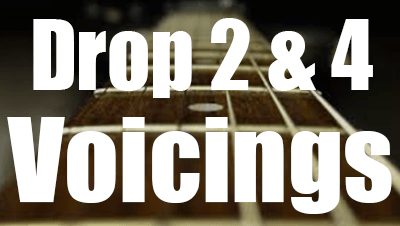 What Are Drop 2-4 Chords?
What Are Drop 2-4 Chords?Drop 2 and 4 chords are created by dropping down an octave the second and fourth note of a seventh chord in close position. They can be very important tools for composition and arrangement. This lesson with diagrams provides useful explanations on how to build and play drop 2 & 4 chords on guitar.
-
Tetrad Chords / Seventh Chords - Music Theory with Guitar Shapes
- By jazz-guitar-licks
- On 2018-09-11
- 2 comments
What's a Tetrad ?
A basic chord is built with three notes this is what we call "triad chords" or "triads". Tetrad chords aka "four note-chords" or "seventh chords" are simply chords containing four notes, “tetra“ is a Greek root meaning four. Tetrads can be seen as triads with an additional note which can be a major seventh (7) or a minor seventh (b7).
-
Arpeggio Practice - Seventh Chords - 4 Essential Exercises
- By jazz-guitar-licks
- On 2018-09-09
- 2 comments
 Arpeggios are essential musical tools that allow you to build pure and beautiful lines while highlighting the harmony. When playing over chord changes, using arpeggios is the most efficient way to connect these chords together.
Arpeggios are essential musical tools that allow you to build pure and beautiful lines while highlighting the harmony. When playing over chord changes, using arpeggios is the most efficient way to connect these chords together.This lesson provides four exercises with tabs, standard notation and diagrams that will help improve your guitar skills and your theoretical knowledge.
-
Dominant 7 Chord Altered Extensions - Guitar Infographic
- By jazz-guitar-licks
- On 2018-05-01
- In Infographics
- 0 comments
Dominant 7 Chord Altered Extensions - Guitar Infographic
-
Drop 2 Guitar Chord Shapes - Infographic
- By jazz-guitar-licks
- On 2018-04-29
- In Infographics
- 0 comments
This infographic with guitar freatboard diagrams show how to play all five types of drop 2 chords on the first set of strings (E, B, G and D strings).
-
Voice Leading For Guitar - 5 Easy Exercises
- By jazz-guitar-licks
- On 2018-04-24
- In Chords / Voicings
- 0 comments
"Voice leading" is a term that refers to the smooth progression of each voice of a chord.
This technique consist to move individually one or several voices up or down by a step from one chord to the next.
This is very used by composers and improvisers in order to connect chords instead of bouncing them around.
The aim of this lesson is to connect or voice-lead basic four-note chords of the same types by moving only one voice.
This should help you learn some of the most important chords used in jazz guitar.
-
5 Jazz Tunes Arranged For Chord-Melody You Need To Know
- By jazz-guitar-licks
- On 2018-04-18
- In Jazz Standards
- 0 comments
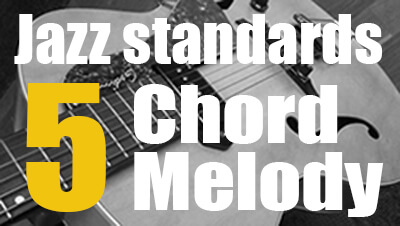 Focusing on jazz standards is surely the best way to accelerate the learning process of jazz guitar, making sure to choose easy songs with a few numbers of chords and melodies that can be easy to hear, play and memorize. When learning jazz guitar, it's very important to spend time learning famous jazz songs, it is an essential part of being a jazz musician. Many guitar students are able to play a ton of chords, arpeggios and scales but they can't play a jazz tune mixing both the melody and the chords.
Focusing on jazz standards is surely the best way to accelerate the learning process of jazz guitar, making sure to choose easy songs with a few numbers of chords and melodies that can be easy to hear, play and memorize. When learning jazz guitar, it's very important to spend time learning famous jazz songs, it is an essential part of being a jazz musician. Many guitar students are able to play a ton of chords, arpeggios and scales but they can't play a jazz tune mixing both the melody and the chords.Here are 5 easy chord-melody arrangements of popular jazz songs for beginning jazz guitarists. Each lesson is available for free as a YouTube video with guitar chord diagrams overlayed in real time.
-
Beautiful love (Wayne King, Victor Young and Egbert Van Alstyne)
-
Misty (Errol Garner)
-
Moon river (Henry Mancini)
-
Stella by startlight (Victor Young)
-
Autumn Leaves (Joseph Kosma)
-
Drop 3 Chords - Guitar Diagrams And Music Theory
- By jazz-guitar-licks
- On 2018-04-07
- In Chords / Voicings
- 0 comments
Drop voicings are chords which span more than an octave. They are very useful tools in music composition and arrangement and are greatly appreciated by guitarists for comping and soloing.
There are several types of drop voicings as drop 2, drop 3, drop 3-4, drop 2 and 4 voicings and drop 2-3-4 voicings.
In this lesson you will learn how drop 3 voicings are built and how to play them on guitar.
-
Autumn Leaves - Easy Chord Melody Arrangement For Beginners - Tabs and chords
- By jazz-guitar-licks
- On 2018-03-31
- In Jazz Standards
- 0 comments
Autumn leaves is one of the most popular non-American jazz standards on pick-up gigs and records. It is a must-know tune for any jazz guitarist and a great choice when you want to play both chords and melody on guitar. This guitar lesson provides an easy chord melody arrangement to play this famous jazz tune.
-
How To Play Autumn Leaves - Jazz Guitar Chords - Advanced lesson
- By jazz-guitar-licks
- On 2018-03-16
- In Chords / Voicings
- 0 comments
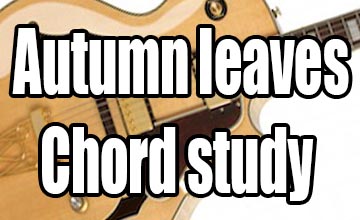 Autumn leaves is a 1945 song composed by French musician Joseph Kosma. The original lyrics are in French, written by Kosma but in 1947 Johnny Mercer wrote the English ones. Since that time it has become a very popular song and surely one of the most played jazz standards.
Autumn leaves is a 1945 song composed by French musician Joseph Kosma. The original lyrics are in French, written by Kosma but in 1947 Johnny Mercer wrote the English ones. Since that time it has become a very popular song and surely one of the most played jazz standards.This song is in a AABC form (32 bars), very much appreciated by beginners because the harmonic progression is pretty simple to play and easy to understand. It covers a very important chord sequence found in jazz, the ii-V-I both in minor and major.
-
25 Altered Dominant Guitar Chords
- By jazz-guitar-licks
- On 2018-03-04
- In Chords / Voicings
- 1 comments
Altered dominant chords are used to bring tension and an outside flavor to jazz chord progressions.
They generally resolve to an inside chord as the I or a substitute as iii or vi.
They have one or more notes lowered or raised by a half-step, in other words they contain one or more alterations.
These alterations are b9,#9, b5 (#11) and b13 (#5).
Altered Chords are generally used by jazz musicians, composers and arrangers as substitutions for diatonic chords for adding dissonance and spicing up the harmony.
-
How To Connect Jazz Guitar Chords (Drop 2)
- By jazz-guitar-licks
- On 2018-03-02
- In Jazz Guitar Lessons
- 0 comments
Drop 2 chords are very important tools in jazz music. They are very useful for comping, chord soloing, harmonizing and building chord melodies.
The first chapter of this lesson provides all the drop 2 voicing shapes, major seventh (M7), minor seventh (m7), dominant seventh (7), half-diminished (m7b5) and diminished seventh (dim7) to play on the guitar neck.
The second explains how to connect them with notes of the major scale.
-
What Is a Backdoor Progression And How To Play Over It
- By jazz-guitar-licks
- On 2018-01-27
- In Jazz Guitar Lessons
- 0 comments
In jazz, there are many types of turnarounds and progressions that eventually we all must encounter. A key part of how you practice should be in preparing yourself for these progressions and turnarounds.
Whether that is by learning a shed-full of Parker’s II V I licks, by practicing exercises over progressions or even by learning a new standard.
The end result is that you are better equipped to deal with what is in front of you in the moment on the bandstand.
To this end, I’m going to talk to you today about a progression known as the backdoor progression.
-
The 14 Most Important Jazz Chord Progressions
- By jazz-guitar-licks
- On 2017-10-30
- In Jazz Guitar Lessons
- 8 comments
In this lesson you will learn to recognize 14 important jazz chord progressions as minor and major II-V-I, turnarounds and their variations, how to use diminished passing chords...etc.
You will also find charts with roman numerals to easily transpose these harmonic progressions in different keys and some examples of comping with audio files, tabs and standard notation.
-
Barry Galbraith jazz guitar study - Like someone - Guitar comping video with bass lines
- By jazz-guitar-licks
- On 2017-10-10
- In Jazz Guitar Lessons
- 4 comments
A new video has been uploaded on the YouTube channel. It is a Barry Galbraith comping study named "Like someone". This is the last study from the Barry Galbraith book "Jazz guitar comping series, vol #3" published by Jamey Aebersold.
Most of the accompaniments studies (comps) in this book are designed to accompany a melody or an improvised solo with bass lines like a pianist would do. It is a very great book to practice jazz guitar comping.
-
Jazz guitar chord voicings - II-V-I progression - 5 Exercises
- By jazz-guitar-licks
- On 2017-06-26
- 0 comments
You will find in this page 5 exercises to learn to play different jazz guitar chord voicings over the most used chord progression in jazz, the famous II-V-I sequence.
-
Jazz Up Basic Guitar Chords - Guitar Lesson for Beginners
- By jazz-guitar-licks
- On 2017-04-27
- In Guitar Practice Tips
- 2 comments
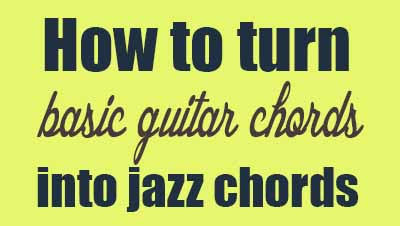 Generally, when a beginner start to learn to play guitar, he tackles open chords (up the guitar neck), those found in many popular songs.
Generally, when a beginner start to learn to play guitar, he tackles open chords (up the guitar neck), those found in many popular songs.Then, come the bar chords (major, minor, dominant 7) a little hard to master. But all these chords do not have a very interesting sound and are not mostly used in jazz music.
That's why in this lesson for jazz beginners we will take the main basic guitar bar chords to transform and enrich them so that their sonority is richer, exciting and better suited to jazz concept.
-
The Tritone Substitution - Guitar Lesson With Theory and Tabs
- By jazz-guitar-licks
- On 2017-04-13
- 2 comments
The tritone substitution sometimes referred to as dominant chord substitution is one of the most popular harmonic technique found in jazz and other styles of music.
It involves replacing a dominant seventh chord with another dominant seventh chord located a tritone (or augmented fourth) away from the original chord's root.
-
Stella by Starlight - Jazz guitar chord melody lesson
- By jazz-guitar-licks
- On 2017-04-11
- 1 comments
A new video is online on the youtube channel. It is a quick jazz guitar chord melody arrangement with chord diagrams of the famous jazz standard "Stella by Starlight" (Victor Young).
-
What's a Half-Diminished Chord (m7b5)
- By jazz-guitar-licks
- On 2017-04-07
- 2 comments
This guitar lesson explains what is m7b5 chord, how to play it on guitar and how to apply it in common harmonic contexts as major and minor II-V-I progressions.
-
List of Musical Intervals - Music Theory
- By jazz-guitar-licks
- On 2017-04-06
- In Music Theory
- 2 comments
What is an Interval ?
An interval is the distance between two notes, each one is represented by a number (1,2,3,4,5,6,7...) and a prefix related to its quality ("M" for major, m for minor, "P" for perfect, "d" for diminished and "A" for augmented). There are five different qualities.
An interval can be melodic, when the tones are successive (played one after the other) and harmonic, if the notes are stacked (played simultaneously). Knowing the name of each interval on guitar and on any other instrument is very important.
Intervals are essential elements of music theory. Intervals are very useful to understand how chords and scales are built. This article shows you how to make the difference between them.
-
Extended Major 7th Chords | Guitar Diagrams & Voicings
- By jazz-guitar-licks
- On 2017-04-01
- 0 comments
Seventh chords (aka four-note chords) represent the backbone of jazz harmony. It is common to extend them with extra tones. These other notes form the upper structure of a chord which includes the 9th, 11th and 13th.
Adding extensions to chords help to get off the beaten tracks and provides some new harmonic colors to your playing (chord soloing, comping, and arrangement).
This lesson provides useful extended major 7th chord shapes to apply to your playing.
-
Chord Substitutions For Guitar
- By jazz-guitar-licks
- On 2017-03-25
- 0 comments
Chord substitution is to replace a chord by another one to add more harmonic interest to a piece, a song or a chord progression.
In jazz music, this technique is widely used by composers and improvisers.
It can be useful to reharmonize a chord sequence or a jazz standard.
This lesson will help you better understand what is the diatonic chord substitution.
-
Walking Bass Lines With Chords And Solo Lines - Guitar Lesson | Bb blues jazz progression
- By jazz-guitar-licks
- On 2017-02-20
- 0 comments
This lesson is about a 12-bar blues in the key of Bb included two guitar transcriptions with tabs : a guitar walking bass line for the accompaniment and a guitar improvisation to solo over.
Note that this study is based on a common blues jazz progression? but with a descending chromatic progression in bars 7 & 8 using three dominant 7th chords (Bb7, A7, Ab7) to approach G7 at the end of the bar 8.
Bb7 | Eb7 | Bb7 | % |
Eb7 | Edim7 | Bb7 A7 | Ab7 G7 |
C-7 | G7 | Bb7 G7 | C-7 F7 |
-
Minor and Major 6 chords on Guitar | 24 Diagrams and Voicings
- By jazz-guitar-licks
- On 2017-02-04
- 0 comments
Understanding and playing 6th chords—both major and minor—is a powerful way to add richness and color to your guitar playing.
These chords are versatile and frequently used in jazz, blues, rock, and pop music, offering a melodic and harmonic depth that goes beyond standard major and minor chords.
This lesson provides 24 guitar diagrams and voicing charts to play major 6 and minor 6 chords on guitar.
-
So What Chord - Jazz Rhythm Guitar Lesson - Modal Comping
- By jazz-guitar-licks
- On 2017-01-24
- 0 comments
Welcome to this lesson on one of the most iconic and modern-sounding chord voicings in jazz — the "So What" chord. Made famous by pianist Bill Evans on Miles Davis’s legendary tune "So What".
In this lesson, we’ll break down how to play the "So What" chord on the guitar, explore its structure, and learn how to move it around the neck.
Whether you're new to quartal harmony or looking to expand your chord vocabulary, this voicing will open up a fresh, sophisticated palette for your playing.
-
There Will Never Be Another You - Jazz Guitar Chord Lesson
- By jazz-guitar-licks
- On 2017-01-20
- In Jazz Standards
- 0 comments
"There Will Never Be Another You" is a popular song by Harry Warren (music) and Mack Gordon (lyrics).
It is one of the most known jazz standards and an indispensable study for any jazz guitarist.
This jazz guitar lesson provides you different chord voicings (drop 2, inverted, rootless and extended chords) on the top four strings of the guitar to comp over this jazz tune.
-
Chords in Fourths - Quartal Harmony
- By jazz-guitar-licks
- On 2017-01-07
- 2 comments
To enrich and modernize the harmonization of a piece it is common to use fourth chords.
They can replace some original chords to bring more melodic freedom into improvisation and more tension in harmony.
Since the late 1950s, harmony in fourths has played a very important role in the development of modern jazz.
Musicians and composers have used a lot quartal harmony.
Among them, the great American pianist McCoy Tyner, who, is a master in the art of playing quartal chords. Mike Stern, Herbie Hancock, Chick Corea, Bill Evans and Kurt Rosewinkel have also used this technique.
In this lesson with tabs and shapes, we will see how to build chords in fourths, how to harmonize the major scale with and how to use them in comping.
-
What's the Major 2 5 1 Progression - Guitar Lesson with Shapes , Tabs and Licks
- By jazz-guitar-licks
- On 2016-12-22
- 0 comments
The major 2 5 1 sequence is the most common chord progression used in jazz music but also in a whole number of styles of music as pop, rock, blues, country.
It is present in many jazz standards (Summertime, Autumn leaves, Blue bossa, All the things you are and many more), this is why it is very important to master it.
-
Harmonization Of The Major Scale - Guitar Lesson With Shapes and Charts
- By jazz-guitar-licks
- On 2016-12-19
- 2 comments
Scale harmonization is the process of creating chords from each note of a given musical scale. This is one of the fundamental theoretical elements to understand music.
This lesson explains how to create triads and seventh chords from each note of the major scale.
-
What Are Drop 2 Voicings - How To Play Them On Guitar
- By jazz-guitar-licks
- On 2016-12-09
- 0 comments
Drop 2 chords are very used and appreciated by guitarists of all styles, they are formed by dropping the second highest note of a four-note chord in close position down an octave.
This guitar theory lesson with diagrams and charts explains how drop 2 chords are built and how to play them.
-
Misty - Arrangement with chords & melody - Jazz guitar lesson
- By jazz-guitar-licks
- On 2016-12-03
- In Jazz Standards
- 4 comments
Misty is a jazz standard written by Erroll Garner following a 32-bar progression in the key of Eb including some common chord sequences as II-V-I, I-VI-II-V. A very popular ballad that has crossed over genres of music for the past 50 years (1959). This lesson provides a guitar chord melody arrangement with a Youtube video and a brief analysis.
-
84 Triad Chords For Guitar | Open and Close Voicings | Root Positions & Inversions
- By jazz-guitar-licks
- On 2016-11-26
- 4 comments
Mastering triads is necessary for any guitarist who wants to expand his fretboard and theory knowledge.
Even if these chords are not really considered as jazz chords because of their basic sound, but they can be efficient tools for comping and chord soloing.
Indeed, the strong point of these chords is the simplicity of learning and playing.
You will find in this guitar lesson 84 ways of playing triads (major, minor, diminished and augmented) using root and inverted voicings in close and open positions.
-
How Chords Are Built - Music Theory
- By jazz-guitar-licks
- On 2016-11-12
- 0 comments
How Chords Are Built?
Chord formulas show all the notes which constitute a chord.
They reveal their structure and provide a link between scales and arpeggios.
Why Learning Chord Formulas
Knowing the structure of chords will help you find any chord position on the guitar when you only have the name.
This will help you better understand the difference between many types of chords.
Learning chord formulas is necessary for anyone who wants to expand their musical knowledge and increase their guitar playing skills.
The formula chart below show how the main types of chords are built.





